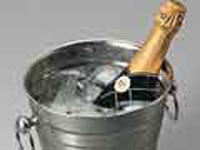Fizzy about champagne: sparkling wine sales jump up in US
By Margarita Snegireva. Raise a glass of champagne for champagne. Fizz is back.

Not since the buying frenzy of 1999, when people bought champagne in bulk to ring in the millennium, have U.S. champagne and sparkling wine sales been so high. Volume for 2007 is expected to hit 900 million glasses, up 4% over 2006, says the 2007 Impact Annual Wine Study.
"Americans are developing a taste for champagne and sparkling wine - slowly, but it's growing," says Frank Walters, director of research.
Driving the rising sales: growing consumer interest in rosé and a broader taste for sparkling wines, such as champagne. Consumers are becoming more educated about price, flavors and the right match with food, much as they did with wine in the past decade.
Champagne has featured prominently in popular culture for over a century, due in part to a long history of effective marketing and product placement by leading champagne houses and their representatives, such as CIVC. In time this created an association of Champagne with luxury and exclusivity. The popularity and positive attributes associated with Champagne has caused many other sparkling wine producers not located in the French wine region of Champagne , to incorrectly use the name "champagne" to describe their wines.
The iconic nature of Champagne has long been used as a means of effusive ritual celebration, in which the wine is not consumed so much as "sacrificed". The champagne bottle traditionally smashed off the bough of a ship or aeroplane at its launch is believed to originate in the rather more reserved celebrations surrounding the christening of a baby. The contents of a bottle agitated and sprayed over onlookers from the winners' podium of Formula 1 motor racing and other sports has origins in the earlier patronage of prestige sporting events by the social elite; the extravagant "waste' of the highly valued wine being an expression of the spirit of the Belle Époque . Rock band U2 famously end their concerts in similar fashion, spraying the audience with champagne before leaving the stage
In a similarly extravagant vein, Marilyn Monroe was reputed to have taken a bath in 350 bottles of Champagne.
The "saucer" shaped glass is another Champagne icon associated with a celebrity sex symbol. The Champagne coupe is often claimed to have been modeled on the shape of the breast of a French aristocrat, often cited as Marie Antoinette or Madame de Pompadour. This is almost certainly apocryphal, as the glass was designed especially for sparkling wine in England in 1663, preceding those aristocrats by almost a century, and sparkling Champagne itself by several decades.
Subscribe to Pravda.Ru Telegram channel, Facebook, RSS!





